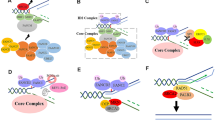Abstract.
Numerous proteins are involved in the nucleotide excision repair (NER) and DNA mismatch repair (MMR) pathways. The function and specificity of these proteins during the mitotic cell cycle has been actively investigated, in large part due to the involvement of these systems in human diseases. In contrast, comparatively little is known about their functioning during meiosis. At least three repair pathways operate during meiosis in the yeast Saccharomyces cerevisiae to repair mismatches that occur as a consequence of heteroduplex formation in recombination. The first pathway is similar to the one acting during postreplicative mismatch repair in mitotically dividing cells, while two pathways are responsible for the repair of large loops during meiosis, using proteins from MMR and NER systems. Some MMR proteins also help prevent recombination between diverged sequences during meiosis, and act late in recombination to affect the resolution of crossovers. This review will discuss the current status of DNA mismatch repair and nucleotide excision repair proteins during meiosis, especially in the yeast S. cerevisiae.
Similar content being viewed by others
Author information
Authors and Affiliations
Additional information
Received 21 September 1998; received after revision 23 November 1998; accepted 23 November 1998
Rights and permissions
About this article
Cite this article
Kirkpatrick, D. Roles of the DNA mismatch repair and nucleotide excision repair proteins during meiosis. CMLS, Cell. Mol. Life Sci. 55, 437–449 (1999). https://doi.org/10.1007/s000180050300
Issue Date:
DOI: https://doi.org/10.1007/s000180050300




